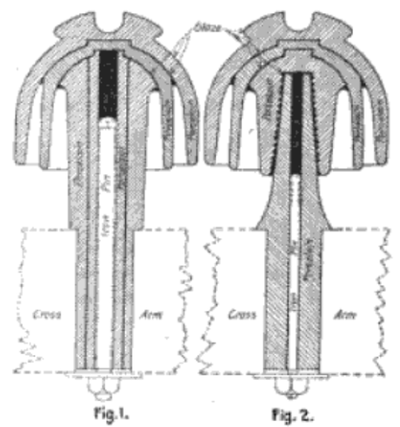[Trade Journal]
Publication: Engineering News
New York, NY, United States
vol. 40, no. 4, p. 51, col. 2-3
A NEW TYPE OF HIGH POTENTIAL INSULATOR.
The insulator shown herewith represents the latest type of a form of insulator developed to meet the requirements of long distance electric transmission. In the early days of low tension and short distances the usual form of glass or porcelain insulators were found quite satisfactory. With increasing pressure it was found that leakage began to be a considerable and dangerous item. This was partially remedied by increasing the number of petticoats, thus increasing the distance over which leakage currents must pass to reach the supporting pin, and at the same time affording more certain drainage during rainy weather. The next difficulty was experienced with puncturing, that is, current piercing the insulation. The natural remedy was to increase the thickness and vary the material. The resulting type of insulator, commonly known as the "Locke", after its inventor, may be described as two insulators, one inside the other, held together by some cementing compound, such as sulphur. The insulator shown represents the latest type intended to obviate the difficulties mentioned. Like the "Locke," it consists of several pieces cemented together, the cementing material, however, being a glaze similar to that used in glazing porcelain ware. In this way the high insulating power of the glaze, which is considerably more than the semi-porous porcelain, is taken advantage of and, as will be seen in Figs. 1 and 2, six layers of glaze and two walls of glaze must be pierced before current can reach the iron pin R. Leakage from the petticoats to the pin is greatly reduced by making the pin also of porcelain. The method of manufacture of this insulator, as described in the patent (No. 601,195, March 22, 1898), is as follows:
 |
| The Boch High Potential Insulator. the R. Thomas & Sons Co., New York City. |
The separately molded porcelain parts, after coming from the press, are dried separately, preferably in an oven or kiln, after the usual manner known as "biscuit firing"; when properly dried and ready for the vitrifying-kiln they are each coated with a glazing material, preferably all over, by dipping. The parts are then fitted together and turned upside down, i. e., drip edges up, forming a bowl into which the glazing liquid is poured until the space between the parts, represented by the black lines in the figure, is filled. The collection of parts is next carefully placed in the vitrifying-kiln and subjected to an intense heat, which melts the glaze and forms a solid, practically impenetrable layer of layers of the best kind of insulating material. The extra amount of glazing liquid prevents the formation of air spaces or cracks and fills all spaces resulting from a lack of correct fit or any shrinkage. Factory tests up to 60,000 volts have been made of this insulator with satisfactory results.
The insulators are manufactured, under patents granted to Mr. J. W. Boch, by the R. Thomas & Sons, Co., 30 and 41 Cortland St., New York city.
